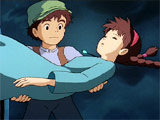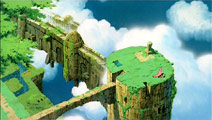

Quick Links:
Laputa: The Castle in the Sky (Tenkuu no Shiro Rapyuta)
Studio Ghibli has a wonderful history, and Laputa was one of its first creations. Created by the dynamic duo (Hayao Miyazaki writing/directing and Joe Hisaishi composing), the film is highly respected to this day and is also the source of inspiration for some later works, such as a Gainax TV series, Fushigi no Umi no Nadia (Nadia: The Secret of the Sea). Featuring amazing animation and great characters to match, Laputa is an essential part of any Ghibli enthusiast's collection.
Laputa is the story of a common boy named Pazu and a fair maiden named Sheeta, who have a somewhat fateful meeting. She falls out of the sky and lands in his arms gently, having been guided safely by the strange jewel around her neck. When she awakens, Pazu learns that she's being chased by a band of pirates and a band of suited goons in cahoots with the military. When the house gets raided by said pirates, Pazu decides to help her escape. The rest of the film is a wild ride over beautiful terrain, eventually turning to a search for the mystical island floating in the sky, Laputa. One of the more readily apparent themes in the film is the purity of a child's heart versus the pursuit of power consuming many adults. It doesn't explore this theme very deeply, which is probably a good thing given the time constraints of motion pictures.
As you might guess from the above description, Laputa's story is nothing to write home about. A story about a boy with an adventurous spirit trying to save a pretty girl and/or fulfill her dreams is a tried and true formula, one already tried many times by the time this film was made. There is a bit more to it than that, of course. Pazu had an interest in Laputa from the start, since his father claimed to have traveled to it and taken a picture (which is on a wall in their house). Sheeta, on the other hand, probably just wanted to be left alone. That is, until she met him. The villains in the story are numerous, but only one seems to have a personal interest in the girl: Muska. He has an arrangement with the army to find her, but for what? The answer is obvious, but how Muska knows her secret isn't revealed until later. The pirates, on the other hand, are only after her precious stone. Aside from an unfortunate plot hole or two, the story of Laputa is thankfully solid, and doesn't attempt to do too much in the time available. The reason to watch Laputa is not the story, though. It is in what you see.
The film has some of the most breathtaking visuals imaginable, and that's no exaggeration. From intricate mountain ranges to grassy cliffs overlooking the sea, to caverns glowing in blue, and finally to the mystic island in the sky, there's nothing to look at in this film that isn't beautifully drawn. All the landscapes have a distant-yet-familiar feel, making the setting and the support characters easy to relate to. The designs of the characters in general were incredibly unique in their day and served as a basis for the overall "Ghibli style" that appeared in several of the later films by Miyazaki. The towns have the appearance of a quaint European mountain village, the likes of which I've seen at a distance from express trains. Some of the charm of the film's visuals is personal to me, but I think most people will identify with at least part of what they see in this movie. On a related note, Disney's transfer was excellent where video is concerned.
There isn't a great deal to say about the music in Laputa, except that it's pleasant and fits the film very well. It was composed by the now well-respected Joe Hisaishi, and he did a fine job but since has done better. The audio of the film is in stereo, which is not surprising given the age of the film. The sound is clear and clean, so Disney gets props again for a good transfer. However, I must say I was extremely disappointed with the job they did on the English subtitling for the film. At times the translation was suspect, and there were several timing errors that plagued the earlier and later stages of the movie. Though mildly irritating, it did not curb my enjoyment of the film.
Generally speaking, Disney did a fabulous job in presenting this Ghibli product to the American masses. The cover image is a medley of images seen in the movie. The insert accompanying the discs lays out what main features are on each disc. The extras on the first disc (containing the feature) are trailers for various Disney-released movies, an introduction to the film by Pixar's John Lasseter, the original Japanese trailers for the movie, and a "Behind the Microphone" special, featuring the voice actors for the English dub. The second disc contains the original storyboards for the film, which can be viewed with either the English or Japanese voice tracks. The extras were nice overall, but I would have liked to see interviews of the Japanese cast and/or staff as well.
I'm happy to have this film as a part of my collection, and it would look good on just about any anime collector's shelf. Despite the over-used formula exploited in its storytelling, light-hearted but mature stories are generally in short supply these days, and seeing this one is a breath of fresh air. For the reasons stated herein, and by the power vested in me, I hereby compel you to view this film, if not purchase it outright.
Distributor: Walt Disney Home Entertainment Creator: Studio Ghibli / Hayao Miyazaki Released: 1986
Plot: B Character Design: A Animation Quality: A+ Music: A- Overall: A-



